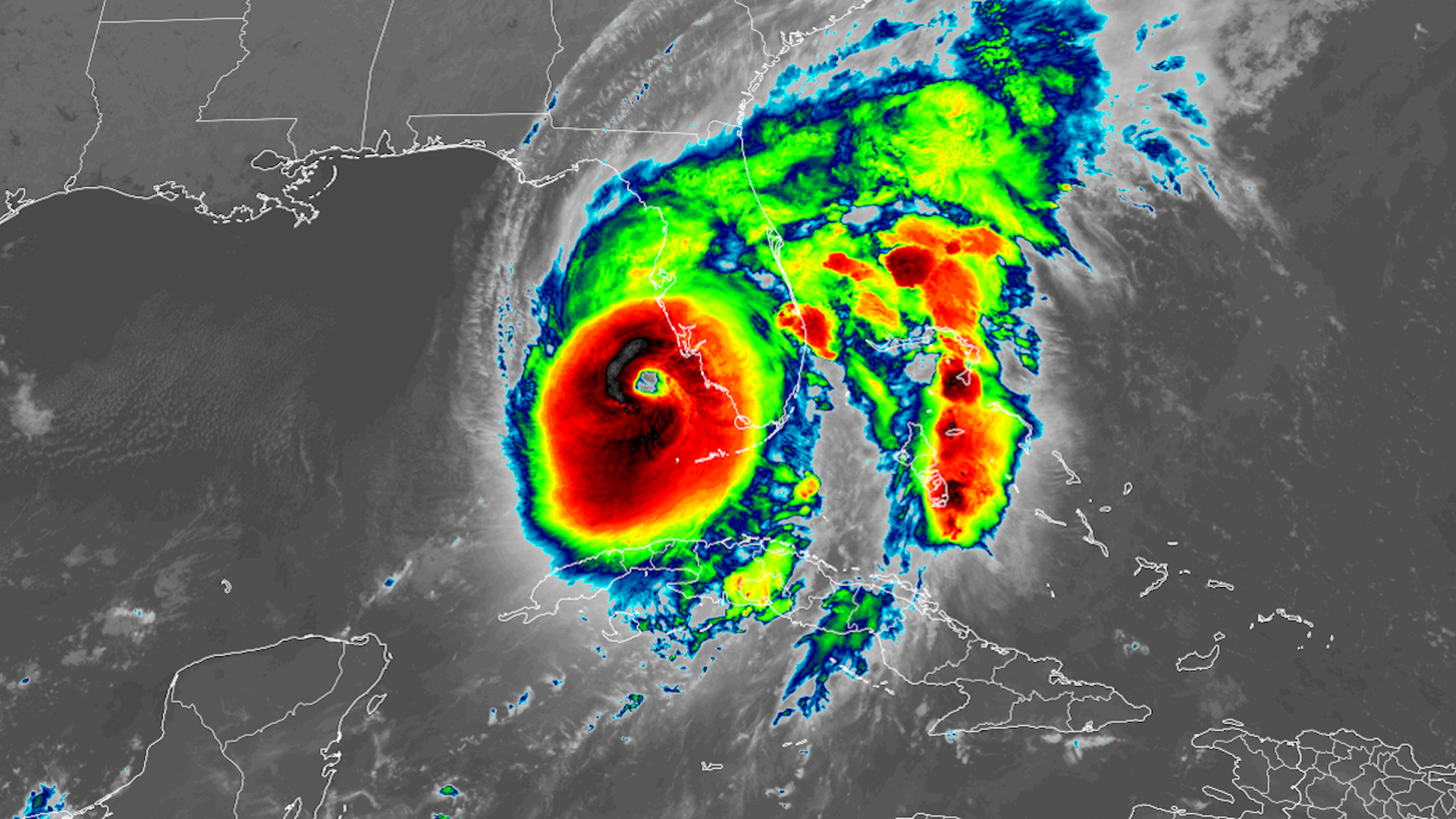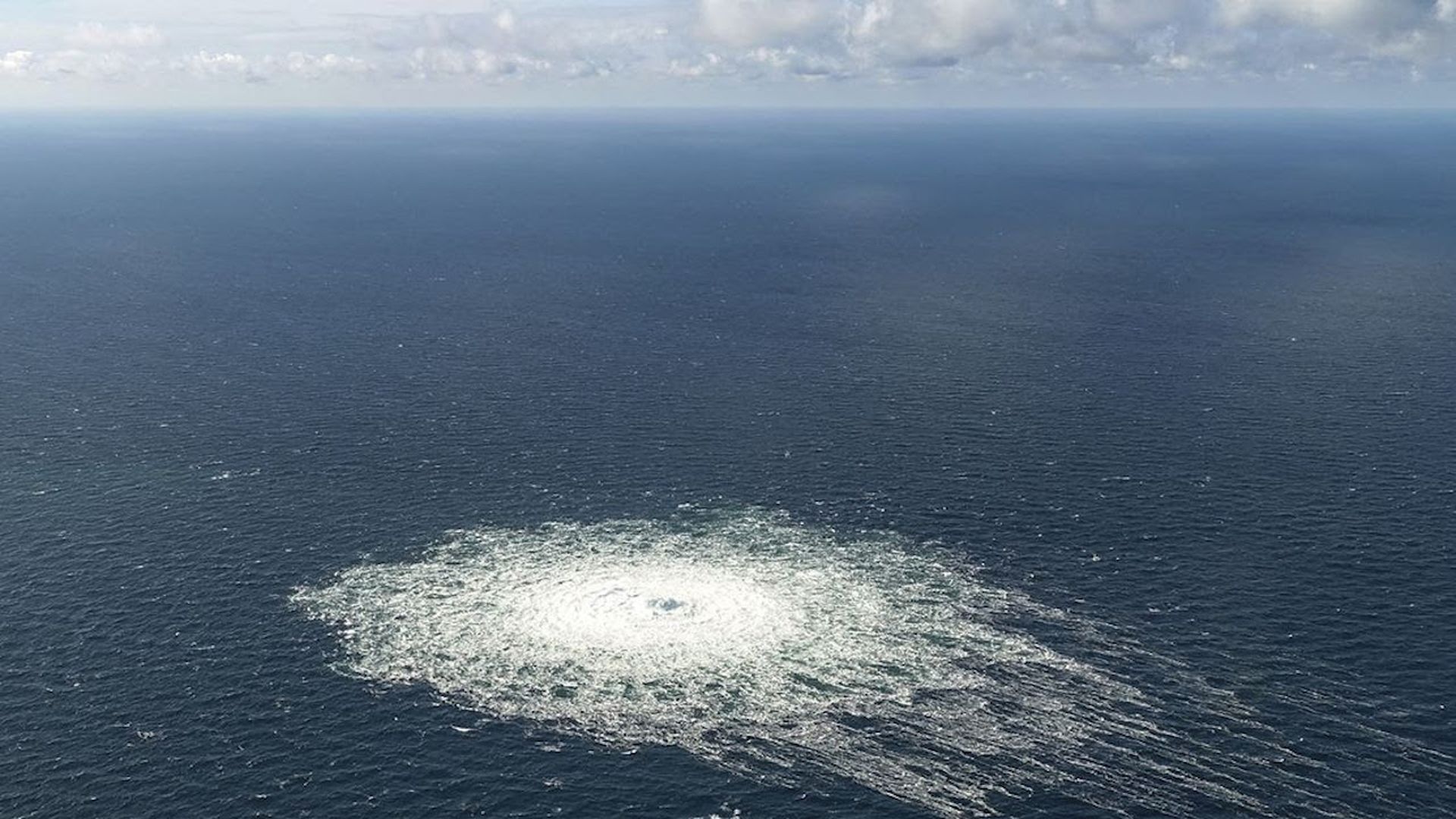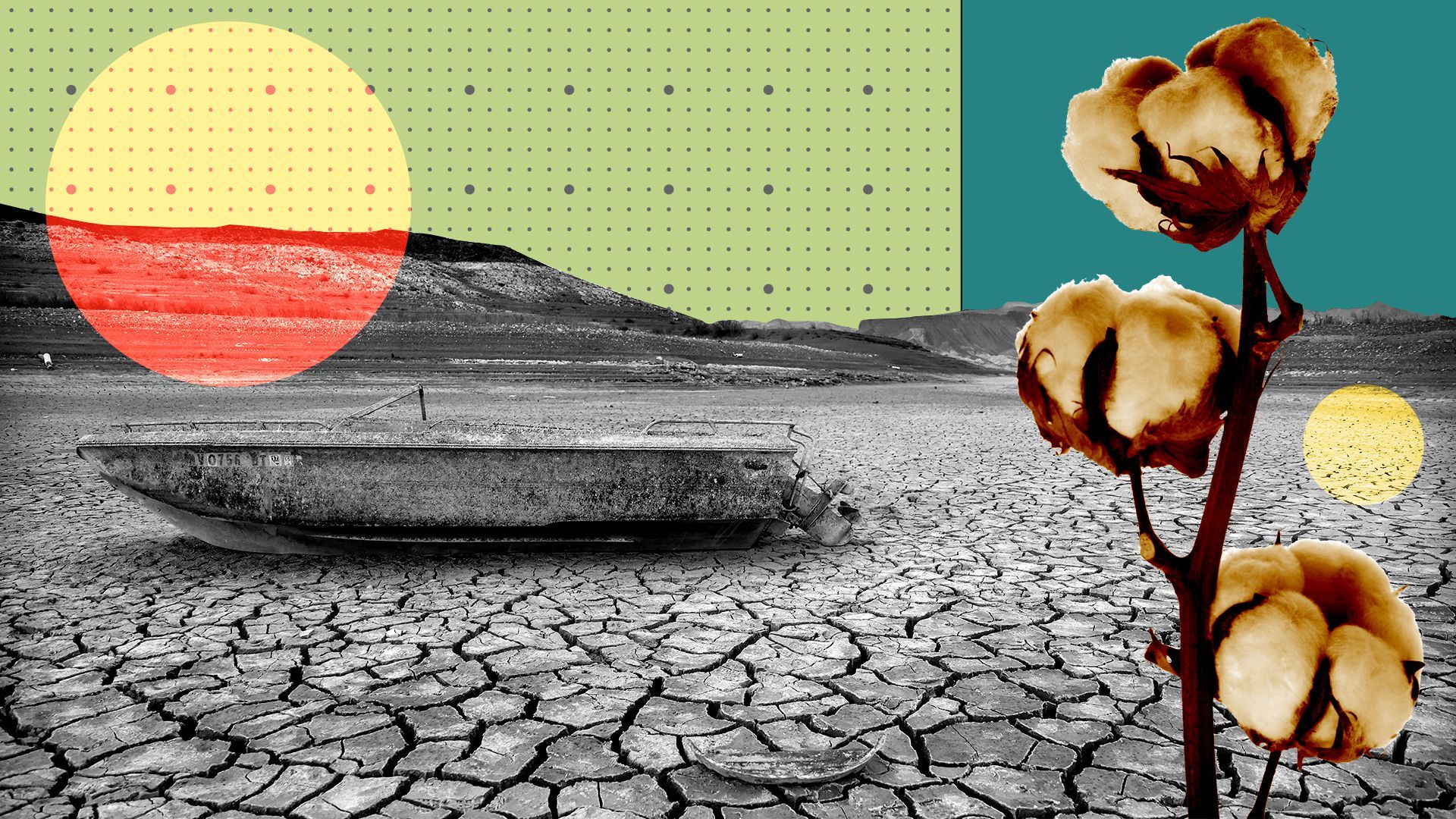| | | | | | | | | | | Axios Generate | | By Ben Geman and Andrew Freedman · Sep 28, 2022 | | 🐪 It's Wednesday already! Today's newsletter has a Smart Brevity count of 1,269 words, 5 minutes. 📬 Did a friend send you this newsletter? Welcome, please sign up. 🎶 At this moment in 1980, George Benson wrapped three weeks atop Billboard's R&B charts with today's irresistible intro tune... | | | | | | 1 big thing: A hurricane nightmare for Florida |  | | | A rapidly intensifying Hurricane Ian nears the Southwest Florida coast on Sept. 27. (CIRA/RAMMB) | | | | Hurricane Ian is slated to move ashore at full, high-end Category 4 fury in southwest Florida, in the vicinity of Fort Myers, early this afternoon, Andrew writes. Threat level: The storm has been rapidly intensifying as it nears the coast and will bring a devastating mix of "catastrophic" damaging winds, as well as life-threatening and historic storm surge flooding along and to the right of where the eye moves ashore. - The water, not the wind, is a hurricane's greatest killer, and the National Weather Service is also highlighting the potential for more than 18 inches of rain for a large portion of central Florida.
- A rare "high" risk outlook for flash flooding is in effect for much of the state.
What's next: Peak storm surge levels are forecast to range from 12 to 16 feet above normally dry land between Englewood to Bonita Beach, including Charlotte Harbor. - This would be an unprecedented surge event for this location.
- Other areas in this region could see surge levels of up to 11 feet.
- In Tampa Bay, far lower surge amounts are expected, about 4 to 6 feet, due to the southerly turn in Hurricane Ian's track.
Context: Climate change makes storm surge flooding more dangerous by increasing sea levels, and giving surge, which is caused by a buildup of water due to a hurricane's onshore winds and low atmospheric pressure, a greater baseline to springboard from. - Climate change is also making hurricanes deliver more rainfall than they used to, due to the added water vapor in the atmosphere from warming sea and air temperatures.
- Hurricane Ian put on a display of rapid intensification during a three-day stretch, reaching Category 4 intensity early today. Trends in storms undergoing such bursts of intensification have also been linked to climate change.
Between the lines: The wind damage will be especially devastating when the storm's large eyewall moves ashore. Hurricane-force winds are likely to spread well inland, possibly north into central Florida. - This will increase the power outage threat to millions of customers beyond just coastal residents.
- The NWS warned today that areas that see the strongest winds "may be uninhabitable for weeks or months."
- Hurricane Ian already has a record of overcoming human-made infrastructure, having taken down Cuba's power grid Tuesday night.
The bottom line: Florida is looking at a multibillion-dollar disaster from Hurricane Ian, one that climate change has likely worsened. Follow live updates. |     | | | | | | 2. Making sense of the Senate permitting collapse |  | | | Illustration: Aïda Amer/Axios | | | | A mix of politics, policy divides and a ticking clock thwarted legislation to speed permitting for energy projects ranging from fossil fuel pipelines to power transmission to renewables, Ben writes. Catch up fast: Sen. Joe Manchin (D-W.Va.) yesterday threw in the towel for the moment. Democratic leaders stripped his proposal from the bill to continue government funding past Sept. 30 after it became clear the measure lacked votes. Why it matters: Renewables industry groups called the proposal needed to realize the goals of the climate bill, which invests in a huge buildout of wind, solar and other low-carbon energy. - But climate activists opposed making it easier to build oil-and-gas infrastructure — and specifically the bill's approval of the Mountain Valley Pipeline gas project. A number of progressive Democrats sided with them.
- GOP lawmakers also want faster permitting, but some argued was too meager. And Senate Minority Leader Mitch McConnell was in no mood to give Manchin a political win.
The bottom line: Add it together and there just wasn't a viable political coalition. What we don't know: Whether efforts to revive the plan, which the White House publicly supports, have a political pulse. - Manchin — in a statement arguing lawmakers are putting politics before energy security — vowed to keep pushing, as did Senate Majority Leader Chuck Schumer.
- The White House — in a statement that blamed Republicans but stayed silent on Democratic opposition — also said it would keep seeking a way to move the measure.
Go deeper. |     | | | | | | 3. Fresh signs of coal's staying power |  Data: Global Carbon Project; Chart: Axios Visuals Recent analyses and news reports together provide the latest evidence that coal's huge role in the global energy mix won't greatly erode soon, Ben writes. Why it matters: Coal's the most CO2-heavy fuel and pathways coming even close to Paris Agreement goals require a steep decline. But that's not happening globally, despite drops in some nations. Driving the news: A few items on my screen help tell the story... - A note this morning from the Centre for Research on Energy and Clean Air (CREA) finds that China's permitting of new coal plants sped up in the first half of 2022. China is by far the world's largest coal user.
- NPR reports that in Germany, amid the loss of Russian gas supplies, "at least 20 coal-fired power plants nationwide are being resurrected or extended past their closing dates."
- The International Energy Agency's latest "Tracking Clean Energy Progress" report finds that coal's share of total global power generation rebounded back above 36% last year.
Yes, but: Getting back to China, the CREA report with Global Energy Monitor points out that despite the permitting increase, initiations of new construction and completions slowed down. - In addition, China's climate targets mean some new capacity could be unused or "stranded."
- Nonetheless: "The presence of large amounts of newly built coal-based capacity complicates the transition economically and politically."
|     | | | | | | A message from Chevron | | At Chevron, we're working to keep up with growing energy demand | | |  | | | | Chevron is increasing U.S. production to keep up with growing energy demand. By the end of this year, we plan to increase our oil and natural gas production in the Permian Basin by 15% over 2021 levels. And we're expected to reach 1 million barrels of oil per day by 2025. Learn more about our efforts. | | | | | | 4. Nord Stream explosions are a climate mess too |  | | | Photo: Danish Defense Command via AP | | | | Two words that are not great when it comes to energy infrastructure — sabotage and methane — are both front and center in Europe right now, Ben writes. Catch up fast: Sweden's national seismic network said yesterday that it registered two explosions near mysterious leaks on the Nord Stream 1 and 2 pipelines, which have prompted concerns of sabotage, Axios' Ivana Saric reports. Neither pipeline was delivering gas from Russia but still contained volumes that are now escaping. Threat level: It's unclear how much of the highly potent planet-warming gas methane is escaping, but it's probably a very large amount, scientists say. "The fear is that it could be one of the worst releases ever," Bloomberg reports. What they're saying: The events "appeared to be a deliberate attack, officials across Europe said on Tuesday, deepening uncertainty about European energy security amid soaring prices and fears of running short of fuel over the winter," per the NYT. - Jake Sullivan, the U.S. national security adviser, said via Twitter that it's "apparent sabotage" and that the U.S. is supporting the investigation.
- Norway and Denmark "have both stepped up security around their oil and gas industries' infrastructure, rigs and buildings," the FT reports.
|     | | | | | | 5. The drought dangers of blowing past Paris |  | | | Photo illustration: Shoshana Gordon/Axios. Photo: Mario Tama/Getty Images | | | | Breaching Paris Agreement temperature goals will greatly boost the odds of long-term, destructive droughts on multiple continents and varying types of ecosystems, a peer-reviewed study finds, Ben writes. Driving the news: New analysis in Climatic Change projects links between drought and warming in China, India, Egypt, Ethiopia, Brazil and Ghana. - Researchers with the U.K'.s University of East Anglia assessed the risks of droughts of one year or longer in a 30-year period under multiple warming scenarios.
- They range from limiting temperature rise to 1.5°C above preindustrial levels — the most ambitious Paris goal — all the way to catastrophic warming of 4°C.
Why it matters: Even in a 1.5°C scenario drought grows considerably — and the world is on track for much more warming absent radical emissions cuts. - But the odds of bad drought rise with more warming. For instance, in a 3°C world, more than half the agricultural land in each nation analyzed is projected to have severe drought in a 30-year stretch.
- It sees 80%-100% of people in Brazil, China, Egypt, Ethiopia and Ghana, and nearly 50% of Indian residents, exposed to severe drought lasting at least a year or longer in a 30-year period.
Read the study. |     | | | | | | A message from Chevron | | At Chevron, we're working to keep up with growing energy demand | | |  | | | | Chevron is increasing U.S. production to keep up with growing energy demand. By the end of this year, we plan to increase our oil and natural gas production in the Permian Basin by 15% over 2021 levels. And we're expected to reach 1 million barrels of oil per day by 2025. Learn more about our efforts. | | | | 📬 Did a friend send you this newsletter? Welcome, please sign up. 🙏Thanks to Mickey Meece and David Nather for edits to today's newsletter. We'll see you back here tomorrow! |  | | Why stop here? Let's go Pro. | | | | | | Axios thanks our partners for supporting our newsletters. If you're interested in advertising, learn more here.
Sponsorship has no influence on editorial content. Axios, 3100 Clarendon Blvd, Arlington VA 22201 | | | You received this email because you signed up for newsletters from Axios.
Change your preferences or unsubscribe here. | | | Was this email forwarded to you?
Sign up now to get Axios in your inbox. | | | | Follow Axios on social media:    | | | | | |










No comments:
Post a Comment